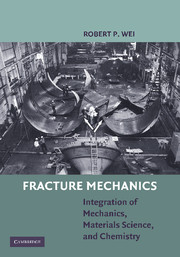Book contents
- Frontmatter
- Contents
- Preface
- Acknowledgments
- 1 Introduction
- 2 Physical Basis of Fracture Mechanics
- 3 Stress Analysis of Cracks
- 4 Experimental Determination of Fracture Toughness
- 5 Fracture Considerations for Design (Safety)
- 6 Subcritical Crack Growth: Creep-Controlled Crack Growth
- 7 Subcritical Crack Growth: Stress Corrosion Cracking and Fatigue Crack Growth (Phenomenology)
- 8 Subcritical Crack Growth: Environmentally Enhanced Crack Growth under Sustained Loads (or Stress Corrosion Cracking)
- 9 Subcritical Crack Growth: Environmentally Assisted Fatigue Crack Growth (or Corrosion Fatigue)
- 10 Science-Based Probability Modeling and Life Cycle Engineering and Management
- APPENDIX: Publications by R. P. Wei and Colleagues
- References
7 - Subcritical Crack Growth: Stress Corrosion Cracking and Fatigue Crack Growth (Phenomenology)
Published online by Cambridge University Press: 05 June 2012
- Frontmatter
- Contents
- Preface
- Acknowledgments
- 1 Introduction
- 2 Physical Basis of Fracture Mechanics
- 3 Stress Analysis of Cracks
- 4 Experimental Determination of Fracture Toughness
- 5 Fracture Considerations for Design (Safety)
- 6 Subcritical Crack Growth: Creep-Controlled Crack Growth
- 7 Subcritical Crack Growth: Stress Corrosion Cracking and Fatigue Crack Growth (Phenomenology)
- 8 Subcritical Crack Growth: Environmentally Enhanced Crack Growth under Sustained Loads (or Stress Corrosion Cracking)
- 9 Subcritical Crack Growth: Environmentally Assisted Fatigue Crack Growth (or Corrosion Fatigue)
- 10 Science-Based Probability Modeling and Life Cycle Engineering and Management
- APPENDIX: Publications by R. P. Wei and Colleagues
- References
Summary
Overview
Stress corrosion, or stress corrosion cracking (SCC), and fatigue/corrosion fatigue, or fatigue crack growth (FCG), are problems of long standing. They manifest themselves in the occurrence of “delayed failure” (i.e., failure after some period of time or numbers of loading cycles) of structural components under statically or cyclically applied loads, at stresses well below the yield strength of the material. These phenomena of delayed failure are often referred to as “static fatigue,” for SCC, or simply “fatigue” for cyclically varying loads. The traditional measure of stress corrosion cracking susceptibility is given in terms of the time required to produce failure (time-to-failure) at different stress levels, as obtained from testing “smooth” or “notched” specimens of the material in the corrosive environments (for example, sea water, for marine applications). For fatigue, the measure is given by the number of cycles to cause failure (the fatigue life) at given cyclic stress levels, or the endurance limit (stress corresponding to some prescribed number of load cycles; e.g., 106 cycles).
The failure time, however, incorporates both the time required for “crack initiation” and a period of slow crack growth so that the separate effect of the environment on each of these stages cannot be ascertained. (Some of the difficulty stems from the lack of a precise definition for crack initiation.) This difficulty is underscored by the results of Brown and Beachem on SCC of titanium alloys.
- Type
- Chapter
- Information
- Fracture MechanicsIntegration of Mechanics, Materials Science and Chemistry, pp. 103 - 119Publisher: Cambridge University PressPrint publication year: 2010



